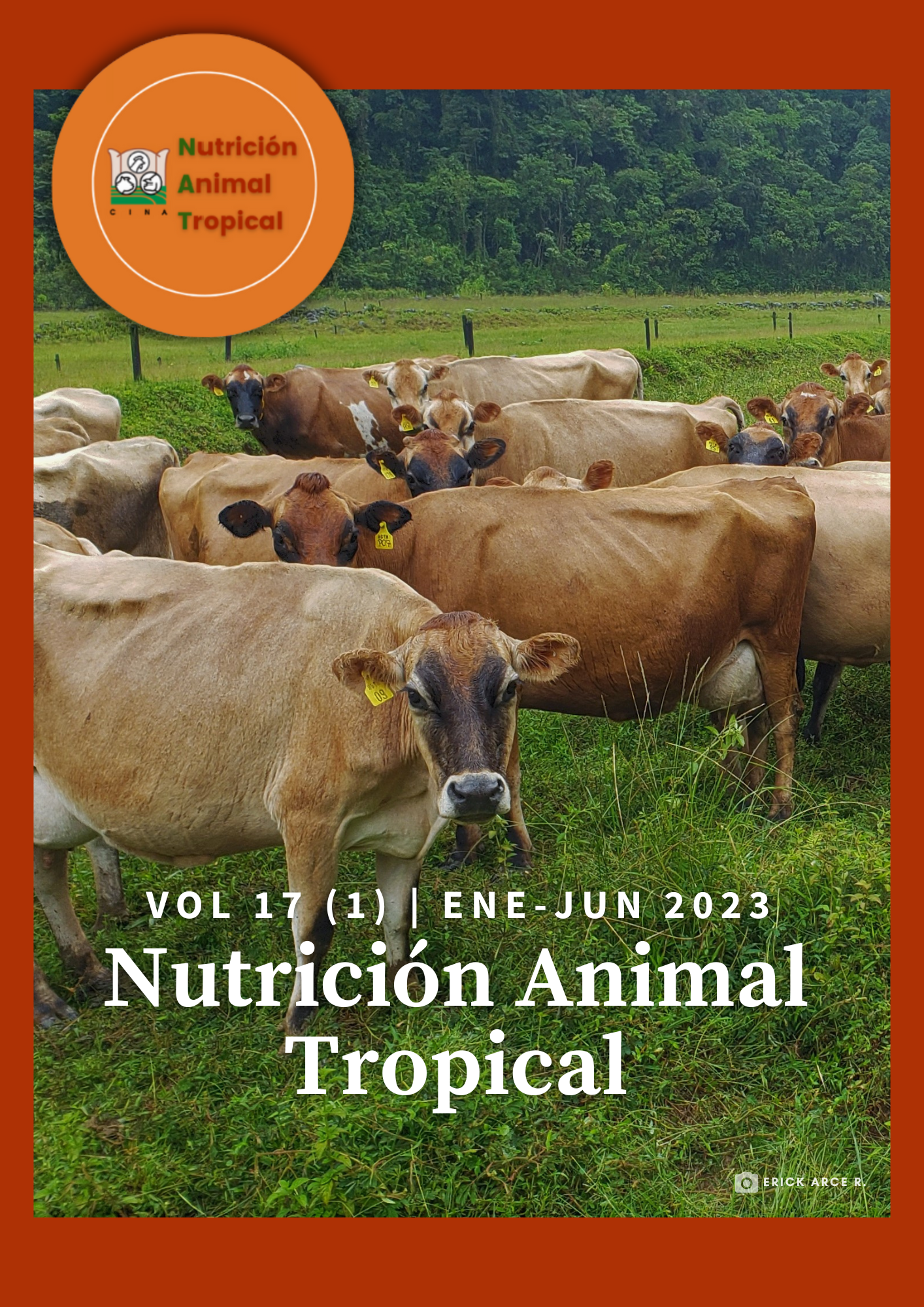Abstract
In rural communities, families usually reared animals in the backyards of their houses in the south of México. The diet of those animals comprises forages and products from milpa. Milpa is a traditional Maya agriculture system where many crops are cultivated, including pigeon pea (Cajanus cajan) a legume with high protein content. The objective of this study was to evaluate the effect of C. Cajan in diets of naked neck growing pullets on productive performance. Three diets were formulated with 25% of C. cajan: soaked in a solution of CaOH (S); soaked in a solution of CaOH and boiled (SB); germinated (G), and a control diet (C) based on maize and soybean meal. Seventy-two pullets seven days old were used. Feed intake, weight gain, and feed conversion were recorded. Data were analyzed with an ANOVA for a random design. There were no statistical differences among treatments for feed intake and daily weight gain (p>0.05) (Average of 63.3 and 36.5 g/bird/day for feed intake and daily weight gain, respectively). Feed conversion in treatment G was higher (1.82) than in the other treatments (1.70 for treatments S, SB, and C) (p<0.05). Results suggest that feed intake and daily weight gain were not affected by the inclusion of C. cajan in the pullet’s diets. However, feed conversion was higher in treatment G in comparison to the other treatments.
References
Abbas Abdel, K., H. Rahman Mohammed, y M. Elamin Ahmed. 2009. Influence of feeding processed pigeon pea (Cajanus cajan) seeds on broiler chick performance. International journal of poultry science, 8 (10): 971-975. doi:10.3923/ijps.2009.971.975
Abd El-Hack, M. E, A.A. Swelum, M.A. Abdel-Latif, D. Más Toro, y M. Arif. 2018. Pigeon Pea (Cajanus cajan) as an alternative protein source in broiler feed. World's Poultry Science Journal, 74 (3): 541-548. doi:10.1017/S0043933918000296
Akande, K.E., M.M. Abubakar, T.A. Adegbola, S.E. Bogoro, y U.D. Doma. 2010. Chemical Evaluation of the Nutritive Quality of Pigeon Pea [Cajanus cajan (L.) Millsp.]. International Journal of Poultry Science, 9 (1): 63-65. doi:10.3923/ijps.2006.60.64
Amaefule, K.U., M.C. Ironkwe, y G.S. Ojewola. 2006. Pigeon pea (Cajanus cajan) seed meal as protein source for pullets: 1 Performance of grower pullets fed raw or processed pigeon pea seed meal diets. International Journal of Poultry Science, 5 (1): 60-64. doi: 10.3923/ijps.2006.60.64
Amarteifio, J.O., D.C. Munthali, S.K. Karikari, y T.K. Morake. 2002. The composition of pigeon peas (Cajanus cajan (L.) Millsp.) grown in Botswana. Plant Foods Human Nutrition. 57 (2): 173-177. doi: 10.1023/a:1015248326920.
Castillo-Caamal, J.B., J.A. Caamal-Maldonado, J.J.M. Jiménez-Osornio, F. Bautista-Zúñiga, M.J. Amaya-Castro, y R. Rodríguez-Carillo. 2010. Evaluación de tres leguminosas como coberturas asociadas con maíz en el trópico subhúmedo. Agronomía Mesoamericana, 21 (1): 39-50.
Castillo-Gómez, C., W. Narváez-Solarte, y C.M. Hahn-von-Hessberg. 2016. Agromorfología y usos del Cajanus cajan L. Millsp. (FABACEAE). Boletín científico. Museo de Historia Natural Universidad de Caldas, 20 (1): 52-62. doi: 10.17151/bccm.2016.20.1.5
Escalante-Aburto, A., B. Ramírez-Wong, P.I. Torres-Chávez, M. Barrón-Hoyos, J.D. Figueroa-Cárdenas, y J. López-Cervantes. 2013. La nixtamalización y su efecto en el contenido de antocianinas de maíces pigmentados, una revisión. Revista Fitotecnia Mexicana, 36 (4): 429-437. http://www.scielo.org.mx/scielo.php?script=sci_arttext&pid=S0187-73802013000400009&lng=es.
Herrera, G.S.M., C.A. Diaz, V.J. Macías, B.T. Solís, y R.G. Muñoz. 2016. Productive performance of chickens fed with Cajanus cajan (gandul) roasted grains. Archivos de Zootecnia, 65 (250): 235-239. https://www.redalyc.org/articulo.oa?id=49545852019
Magaña-Magaña, M.A., y L.L. Salazar-Barrientos. 2016. Aportaciones de la milpa y traspatio a la autosuficiencia alimentaria en comunidades mayas de Yucatán. Estudios Sociales. Revista de Alimentación Contemporánea y desarrollo Regional, 14 (47): 182-203. https://www.redalyc.org/articulo.oa?id=41744003007
Navarro, C.L., D. Restrepo, y J. Pérez. 2014. El Guandul (Cajanus cajan) una alternativa en la industria de los alimentos. Biotecnología en el Sector Agropecuario y Agroindustrial, 12 (2): 197-206. http://www.scielo.org.co/pdf/bsaa/v12n2/v12n2a22.pdf
Novotny, I.P., P. Tittonell, M.H. Fuentes-Ponce, S. López-Ridaura, y W.A.H. Rossing. 2021. The importance of the traditional milpa in food security and nutritional self-sufficiency in the highlands of Oaxaca, Mexico. PLoS ONE, 16 (2): e0246281. doi: 10.1371/journal.pone.02462
Ogbu, N.N., C.C. Ogbu, y A.U. Okorie. 2015. Haematological indices of broiler chickens fed raw and processed pigeon pea (Cajanus Cajan) seed meal. The Journal of Animal Production Advances, 5 (7): 711- 717. https://europub.co.uk/articles/haematological-indices-of-broiler-chickens-fed-raw-and-processed-pigeon-pea-cajanus-cajan-seed-meal-A-117087
Oloyo, R. 2002. Processing effects on the chemical composition and nutritional potential of the pigeon pea (Cajanus cajan, L). La Rivista italiana delle Sostanze grasse, 79 (7): 273-276. https://www.semanticscholar.org/paper/Processing-effects-on-the-chemical-composition-and-Oloyo/648912514d35d2c19be3e7476955eebacfda327d
Onu, P. N., y S.N. Okongwu. 2006. Performance Characteristics and Nutrient Utilization of Starter Broilers Fed Raw and Processed Pigeon Pea (Cajanus cajan) Seed Meal. International Journal of Poultry Science, 5 (7): 693-697. doi: 10.3923/ijps.2006.693.697.
Oso, A.O., O.M. Idowu, A.V. Jegede, W.A. Olayemi, O.A. Lala, y A.M. Bamgbose. 2012. Effect of dietary inclusion of fermented pigeon pea (Cajanus cajan) meal on growth, apparent nutrient digestibility, and blood parameters of cockerel chicks. Tropical Animal Health and Production, 44 (7): 1581-1586. doi: 10.1007/s11250-012-0109-1.
Piñero-Corredor, M.P., K.C. Parra-Quevedo, Y.M. Barboza de Martínez, M.L. Pérez Martínez, y J. Ortega Alcalá. 2013. Efecto combinado de la imbibición y la germinación sobre la calidad del Quinchoncho (Cajanus cajan (L) Millsp.). CIENCIA, 21 (4): 192–200. https://produccioncientificaluz.org/index.php/ciencia/article/view/18749
Safwat, A.M., L. Sarmiento-Franco, R.H. Santos-Ricalde, D. Nieves, y H. Magaña-Sevilla. 2015. Effect of dietary inclusion of processed Mucuna pruriens seed meal on growing rabbits. Animal Feed Science and Technology, 201 (2015): 72-79. doi: 10.1016/j.anifeedsci.2015.01.005
Sarmiento-Franco, L., F. López-Santiz, R. Santos-Ricalde, y C. Sandoval-Castro. 2019. Semillas tratadas de Mucuna pruriens en dietas para pollos de engorda sobre el comportamiento productivo y rendimiento en canal. Ecosistemas y Recursos Agropecuarios, 6 (16): 121-127. doi:10.19136/era.a6n16.1815

This work is licensed under a Creative Commons Attribution-NonCommercial-NoDerivatives 4.0 International License.

